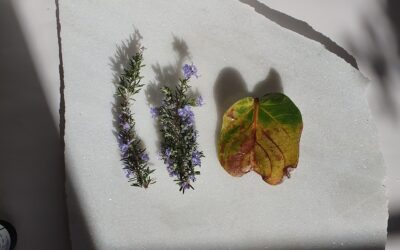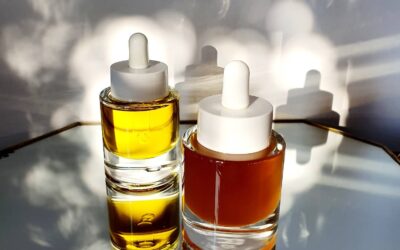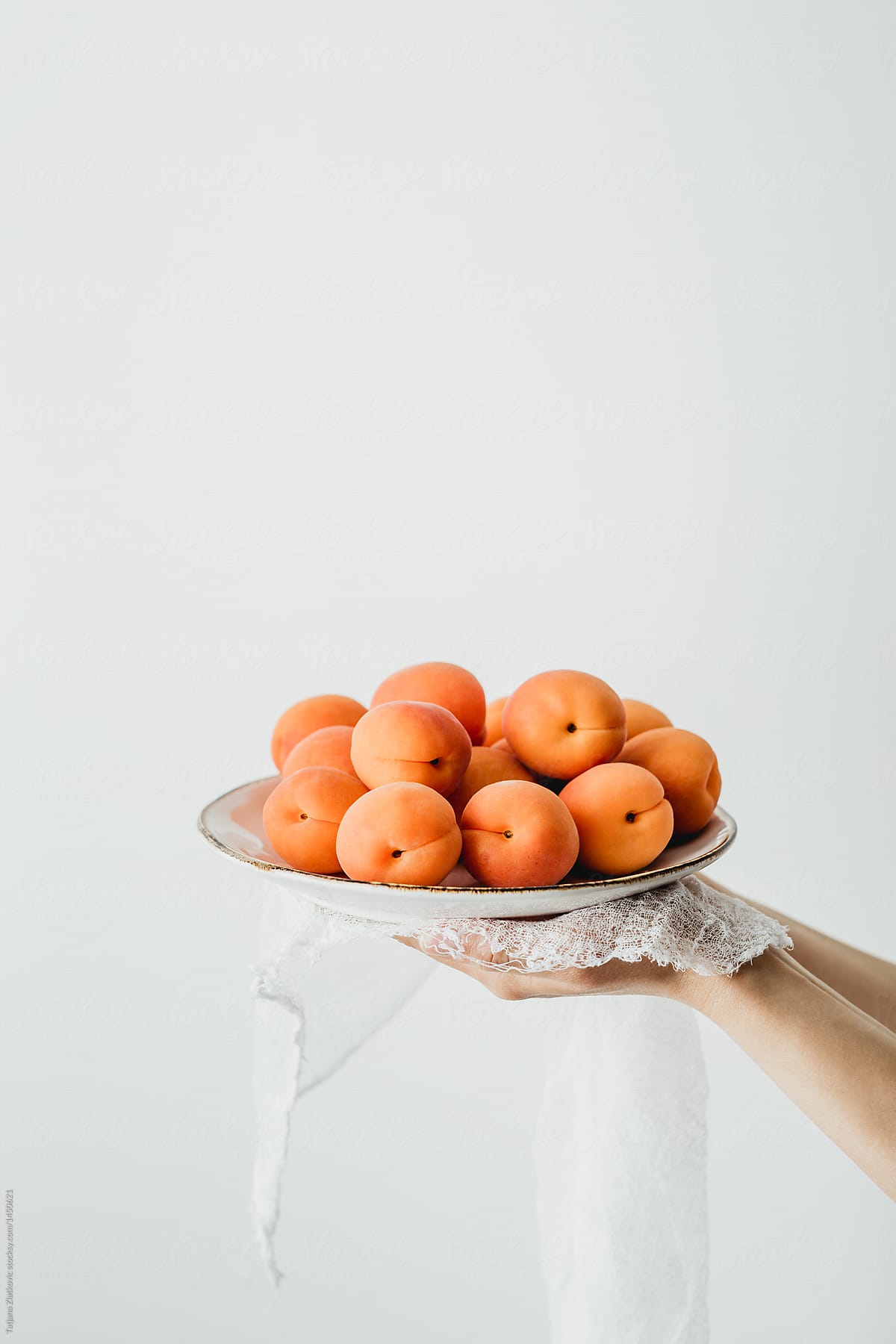
The sunscreening properties of plants
Do plant oils and extracts protect from UVA and UVB? To what extent? This article shares what spectral analysis studies reveal about plant based photoprotection.
One of the most common questions asked regarding the oils I have tested in my home experiment, was whether they protect from UVA and UVB radiation. The short answer is yes and the full answer is this:
“Successive increments in the number of absorbing molecules in the path of the beam of monochromatic radiation absorb equal fractions of the radiation power travel through them”
In simple words, according to the Beer’s and Lambert’s law: the greater the number of molecules that absorb certain wavelength, the greater the absorption.
In even simpler words: the higher the concentration of the UV absorbing molecules in a sample (oil or extract) the higher the protection.
My previous post explained Why and how plant compounds protect from UV.
In short, it is through the process of electron transition, that certain plant molecules work as UV absorbers and this ability is dictated by the specific structure of a given molecule.
Now we know that it is the concentration of these molecules in the plant oil or extract, that dictates their UV screening abilities as explained by the Beer’s and Lambert’s law. But what dictates the concentration of these molecules in the plant?
Plants and the photoprotective molecules they produce
Plants produce UV screening compounds to protect themselves from the damage that excess UV radiation can cause to its photosynthesis machinery. UV radiation is therefore the detrimental factor in the amount of protection a plant will need to produce: the more sun the organism is exposed to, the greater the need for the protection.
While tolerance to UV varies between plant species and varieties, there are also environmental factors that play a role in plants UV exposure. Those factors are:
- Geographical location – plants growing in locations with the highest UV index are more at risk for UV caused damage
- Altitude – the higher the altitude the higher the UV exposure
- Density of planting – higher density creates more shade
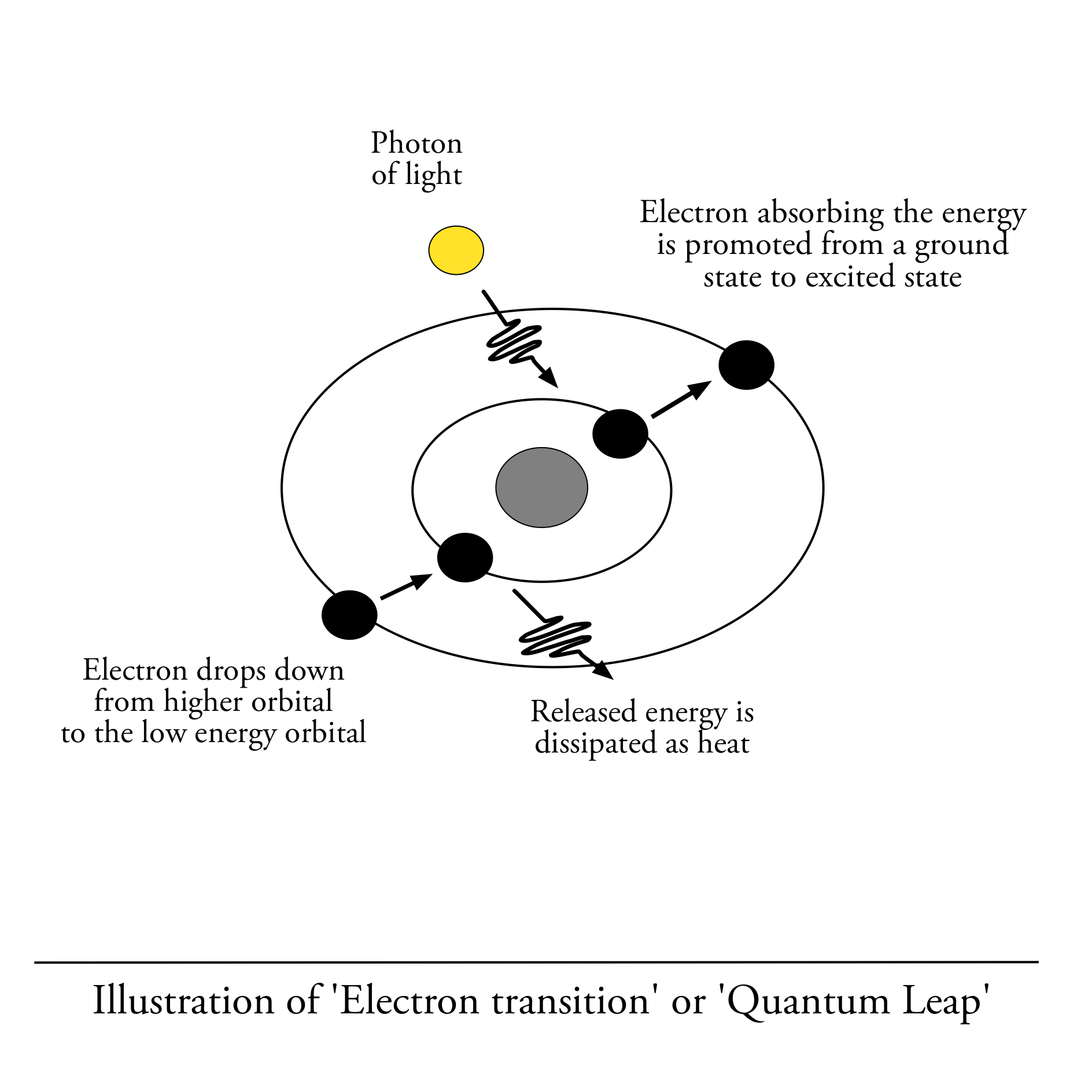
Other factors that play a role in the efficacy of the UV screening molecules in the sample are:
- Extraction method: studies show that extraction method changes the absorption peak of the sample and consequently oils produced from the same sample, but via different extraction (cold press, CO2 extract, hexane, ethanol, acetone, distilled water, ultrasonic) will produce different absorption results and peaks when tested
- Time of the harvest – oils and extracts made from plants harvested in the months of highest UV index will have a higher density of the sunscreening molecules.
- Storage method and time since extraction
- Particle size – this is evident in the studies of mineral blockers such as titanium dioxide and zinc oxide, where the size of the particles affects its efficacy at blocking the UV light.

A study of “Molecular Spectroscopic Analysis of Daucus carota Plant Pigment Extracts” published in Annual Research & Review in Biology 2017
SPF values and UVA absorption spectra of oils
In the first paragraph I have confirmed that the oils I have used in my home experiment protect from UVA and UVB wavelenghts, here are the SPF numbers and UVA absorption spectra based on studies I have found:
- Carrot Root Extract – SPF 1.69 to 24.25
- Carrot Seed Oil – SPF 6.92 to 18.80
- Carrot seed oil – absorbs all UVA between 320 – 340 nm and 70% of UVA after that,
- Almond oil – SPF 4.6, absorbs all UVA between 320 – 365 nm and 95% of UVA after that
- Wheat Germ Oil – SPF 22.40 absorbs all UVA between 320 – 365 nm and 95% of UVA after that
- Raspberry Seed Oil SPF 28 to 50, PFA of 6.75-7.5.
- Coconut Oil – SPF 1.75 to 7.36, absorbs about 20% of UVA between 320 and 400 nm
SPF values and UVA absorption spectra of tested plant oils
Carrot Root Extract and Carrot Seed Oil
A study conducted at the University of Kinshasa and published in the Journal of Chemical, Biological and Physical Sciences · March 2015 conducted in vitro spectral analysis of SPF factors for Carrot and Coconut extracts.
The samples were extracted using two different methods: Ethyl acetate and Aquatious extraction.
The samples were tested at different concentrations of parts per million and showed as follows:
Carrot Extract
SPF 24.25 at 2000/ppm – Ethyl Acetate extract
SPF 13.77 at 1000/ppm – Ethyl Acetate extract
SPF 9.6 at 2% concentration in cream of the Ethyl Acetate extract
SPF 1.69 in an Aqueous extract – this result was also achieved in a study of aqueous extracts here
Coconut Extract
SPF 3.71 at 2000/ppm – Ethyl Acetate extract
SPF 1.75 at 1000/ppm – Ethyl Acetate extract
SPF 7.36 in an Aqueous extract – also duplicated in another study here
![UV-visual-attenuation-spectra-for-various-particle-sizes-of-titanium-dioxide.-Modified-from-Ref.-1060x737 UV/visual attenuation spectra for various particle sizes of titanium dioxide. Modified from Ref. [8]. Engineered Inorganic Nanoparticles and Cosmetics: Facts, Issues, Knowledge Gaps and Challenges. Journal of Biomedical Nanotechnology Vol. 6, 408–431, 2010](https://earthchild.co/wp-content/uploads/2021/01/UV-visual-attenuation-spectra-for-various-particle-sizes-of-titanium-dioxide.-Modified-from-Ref.-1060x737-1.png)
UV/visual attenuation spectra for various particle sizes of titanium dioxide. Modified from Ref. [8].
Engineered Inorganic Nanoparticles and Cosmetics: Facts, Issues, Knowledge Gaps and Challenges. Journal of Biomedical Nanotechnology Vol. 6, 408–431, 2010
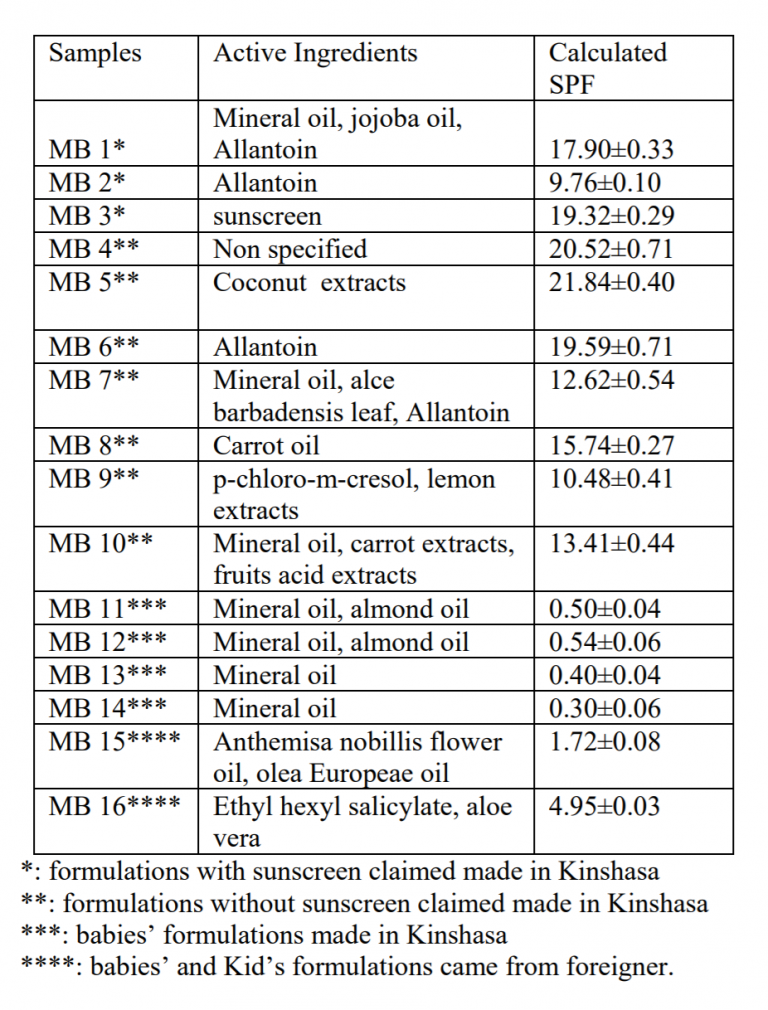
Sun Protection Factor (SPF) Determination of Cosmetic Formulations Made in Kinshasa (DR Congo) by In-Vitro Method using UV-VIS Spectrophotometer, Journal of Physical and Chemical science
In another study published in Journal of Cosmetic and Laser Therapy
Volume 21, 2019 and evaluating the antiaging potential of carrot seed oil (CSO) based cosmetic emulsions, the SPF value of the emulsion containing 6% concentration of Carrot Seed Oil was established to be SPF 6.92
A 2016 study published in International Journal of Pharmacology Research conducted Spectral analysis of Carrot Seed Oil and Wheat Germ Oil The calculated SPF values were as follows:
SPF 18.80 – Carrot Seed Oil
SPF 22.40 – Wheat Germ Oil
Another study conducted at the Institute of Pharmacy, Ravishankar Shukla University in India and published in Pharmacognosy Research in March 2010 tested volatile and non volatile oils, establishing as follows:
- SPF 7.11 – Coconut Oil
- SPF 4.6 – Almond Oil
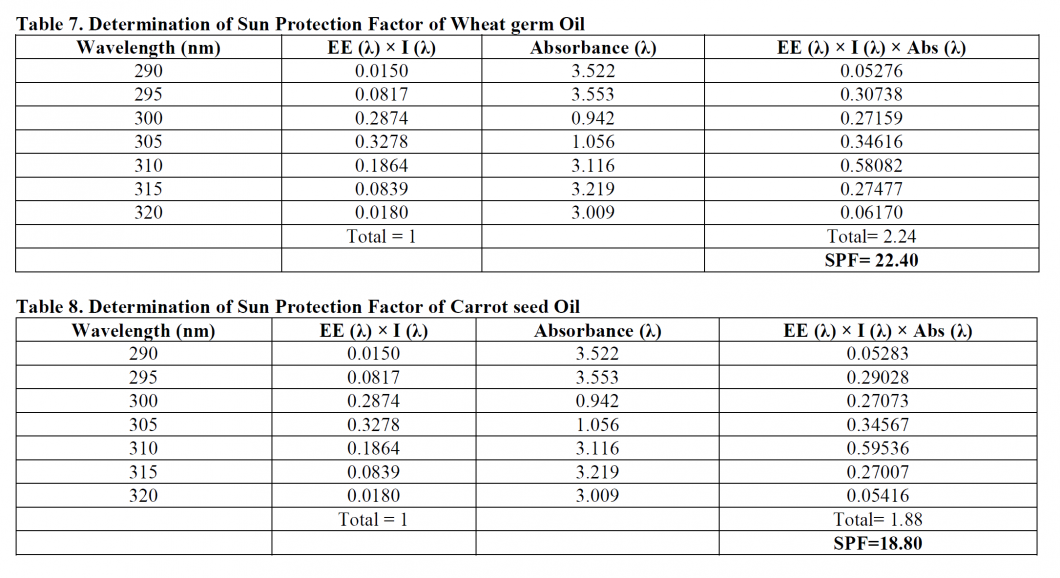
Determination of Sun Protective Factor of Carrot Seed Oil and Wheat Germ Oil, In-Vitro determination of sun protection factor and evaluation of herbal oils, International Journal of Pharmacology Research 2016

What is interesting about this study is that 11 out of 16 tested products showed SPF values between SPF4.95 and 21.84, while only 3 were sold as sunscreen
Another study, also from Kinshasa titled “Sun Protection Factor (SPF) Determination of Cosmetic Formulations Made in Kinshasa (DR Congo) by In-Vitro Method using UV-VIS Spectrophotometer” and published in the Journal of Physical and Chemical science, tested 16 creams and lotions containing natural ingredients for their SPF values.
What is interesting about this study is that 11 out of 16 tested products showed SPF values between SPF4.95 and 21.84, while only 3 were sold as sunscreen. Of the remainder 8, one formulation containing Coconut Extract showed SPF of 21.84 and another containing Carrot oil showed SPF of 15.74, however there is no mention of the concentration used.
Raspberry Seed Oil
A study published in 2000 in Elsevier’s Food Chemistry journal measured the composition and properties of Rusus Idaeus L. commonly known as Red Raspberry Seed Oil.
Spectroscopic analyses found high absorption in the UV range 290-400nm, with SPF value of 28-50 and UVA PFA of 6.75-7.5.
“The optical transmission of raspberry seed oil, especially in the UV range (290-400 nm) was comparable to that of titanium dioxide preparations with sun protection factor for UVB (SPF) and protection factor for UV-A (PFA) values between 28-50 and 6.75-7.5, respectively.”
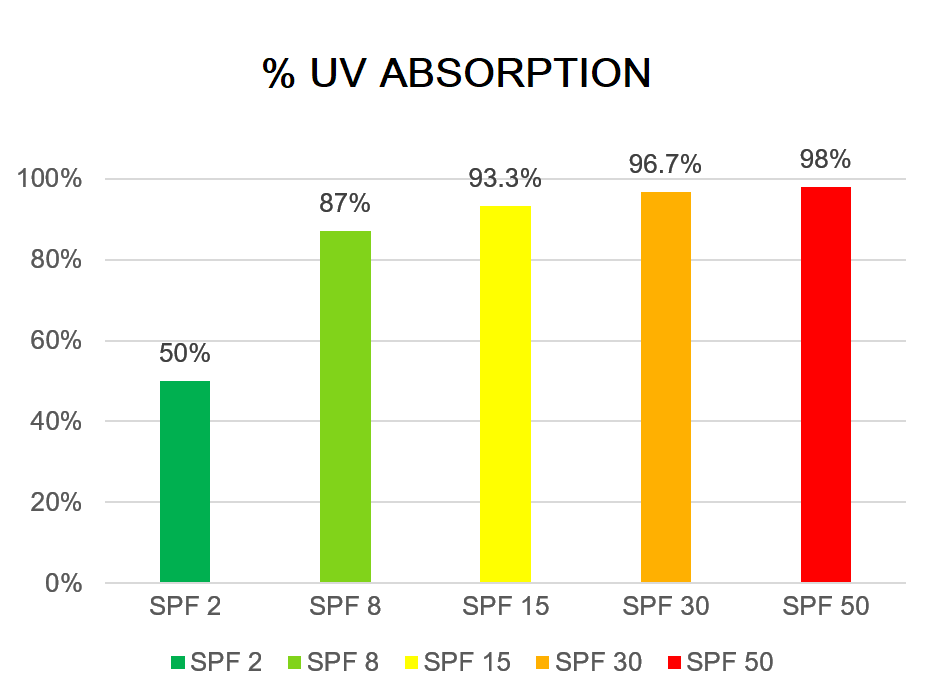
The SPF 28-50 is an equivalent of 96-98% of UVB absorption, as SPF 30 absorbs around 97.6% of UVB and SPF 50, around 98%.
In another study conducted at the Department of Fiber and Polymer Engineering Faculty of Natural Sciences, Architecture and Engineering, Bursa Technical University, Turkey and published in European Scientific Journal June 2014, the investigators tested 10 oils (listed below).
These are the results for the test in the UVA range 320 – 400 nm:
- Carrot seed – absorbs all UVA between 320 – 340 nm and about 70% of UVA after that
- Almond – absorbs all UVA between 320 – 365 nm and about 95% of UVA after that
- Wheat germ – absorbs all UVA between 320 – 365 nm and about 95% of UVA after that
- Grapes seed – absorbs all UVA between 320 – 400 nm
- Apricot seed – absorbs all UVA between 320 – 36 nm and 90% of UVA after that
- Jojoba – absorbs all UVA between 320 – 345 nm and 65% of UVA after that
- Sesame seed – absorbs 90% of UVA between 320 – 330 nm and about 65% of UVA after that
- Avocado – absorbs all UVA between 320 – 350 nm and about 45% of UVA after that
- Cocoa – absorbs all UVA between 320 – 350 nm and about 70% of UVA after that
The results for UVB transmission and absorption were not covered in this analysis.
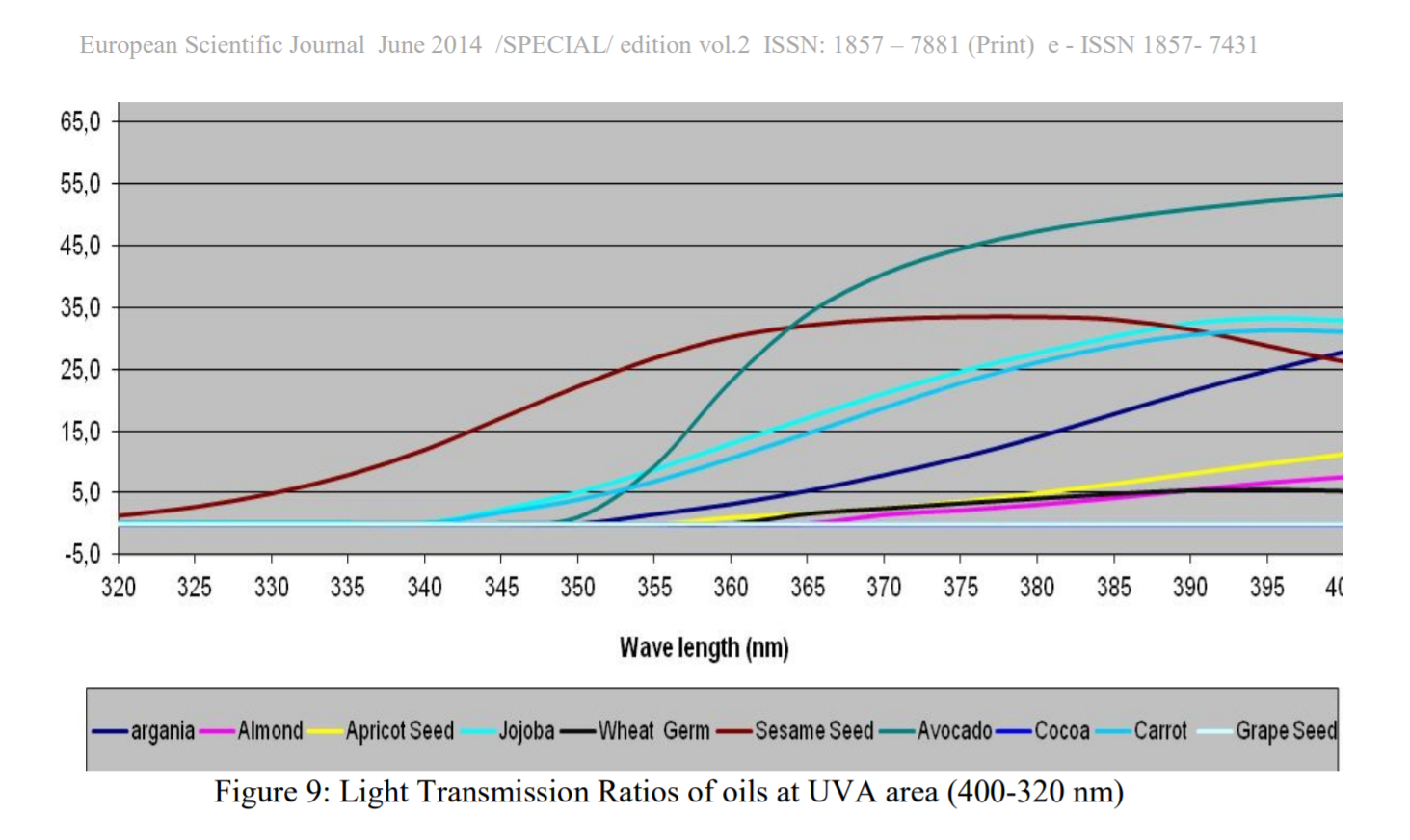
Source “A techinical glance at some cosmetic oils” European Scientific Journal June 2014 /SPECIAL/ edition vol.2 ISSN: 1857 – 7881 (Print) e – ISSN 1857- 7431
How plant oils compare to commercial sunscreens
Synthetic filters are chemically pure molecules that absorb or block UV energy at a specific waveband. Unlike synthetic filters, plant derived oils and extracts are a rich mixture of molecules with varying roles which cover a broader spectrum of absorbance producing at least two different bands in the Visible Light and the Ultraviolet Regions.
In case of organic UV filters, their main protection mechanism is based on electronic transitions in which a photon of sun energy is absorbed by the electron and subsequently emitted as a less harmful energy. However, photoprotection through UV absorption is just one of many functions produced by these molecules. Plant oils and extracts are a very rich source of molecules of varying functions, produced to protect the plant from photo-oxidative damage through their antioxidant, anti-inflammatory and immunomodulatory activities. Majority of these antioxidants are polyphenols which quench the excited state of the harmful Reactive Oxygene Species (ROS) or Free Radicals.
The negative effect of chronic UV exposure is wavelength dependent and lies in its ability to cause sunburn, creation of the ROS and in immune suppression. The UV induced skin damage is mainly caused by the ROS which are responsible for cell lipo-peroxidation, skin aging and tissue damage. Thus plant oils and extracts are able to protect our skin not only by UV absorption, but also by providing protection after the UV exposure by minimizing UV induced redness, inflammation, edema, skin thickening, immunosuppression, tumor formation as well as by the reversal of UV induced damage to our cells and DNA when applied topically and when ingested
The science showing how the consumption of specific plant constituents makes our skin more resistant to sunburn induced photo damage is undeniable and continues to grow.
Synthetic filters besides from providing limited protection against specific wavebands of UV, offer none of the positive health benefits provided by the rich mix of plant antioxidants, vitamins and fats that plant oils contain.
The takeaway
Understanding that plants are living organisms, producing UV screening molecules as a response to the environment they live in, explains why the UV spectral analysis results of plant oils vary from study to study.
When two studies of the same type of plant oil or extract produce different absorption peaks and SPF values, the results do not refute one another, but merely reflect Beer’s and Lambert’s observation that the UV absorption is concentration dependent. Additionally, environmental and physical factors, such as UV exposure of the plant itself, extraction method, particle size, storage conditions also affect the ability of the sample to attenuate UV light.
- Carrot seed oil and carrot extract are effective UVB absorbers and moderate UVA absorbers.
- Wheat Germ oil is potent UVB and UVA absorber.
- Raspberry seed oil is effective UVB absorber and moderate UVA absorber
- Grape seed oil and Almond oil are excellent UVA absorbers
Used together, they make a broad spectrum sunscreen capable of protecting from UVA and UVB while also nourishing the skin with high levels of fats, antioxidants and vitamins.
Related Articles
Rice bran extract
RICE BRANA look into key studies examining the antioxidant, photoprotective and ani-photoageing properties of rice bran extract.Rice bran extractNumerous human and animal studies examined its antioxidant, photoprotective and ani-photoageing properties, giving us a...
How plants protect your skin from sun damage and why
Plants don’t burn in the sun thanks to the sunscreening mechanism they evolved. Eating plants rich in photoprotective molecules allows your body to protect your skin from sun damage. Here is how:
Cold-Pressed versus CO2 Extracted? What you need to know
The same seed, different extraction methods, two very different results. Can you work out which raspberry seed oil was cold pressed and which was extracted by CO2?

